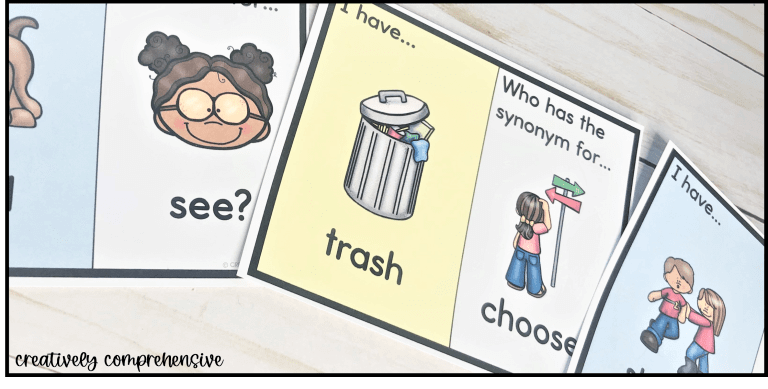Take I Have, Who Has to the Next Level!
I Have, Who Has is a popular classroom game. Teachers and students alike enjoy this whole class game to practice or review key concepts. Even though the original activity is fun as it is, there might be times you want to change it up. Take I Have, Who Has to the next level with these fun twists!

The Basics
Let’s make sure everyone knows how to play the original game first! I Have, Who Has is a whole class card game. To play, each student will need at least one card. Some I Have, Who Has games have a designated “START” card (my games do not- so you can replay the game in any order).

The student with the start card (or the student you choose to start) will begin by reading their card. From the card, they will read the phrase, for example, “I have hot, who has a synonym for large?” The student with the card that says “I have large” would then read their card. This continues until all students have read their cards, and play has returned to the first student.
Small Group Variation
In order to play this game in a small group, you would divide the cards among the students who are in the group. Gameplay is the same, but you may want to take a quick peek to see that each student has a good mix of cards- otherwise, they will be responding to themselves!
Take It to the Next Level!
As much fun as I Have, Who Has can be, your kiddos will only be able to play a certain amount of times before they’re over it. Time to mix it up! We know that there are some topics that really need an extra bit of flair to keep kids interested. These twists should do the trick!
I Have, Who Has Goes Digital
That’s right- this activity has entered the digital age! Although the game experience will be slightly different, the interactive spirit will still be there. Instead of cards, you’ll create a slideshow. There are several ways to play depending on the technology/technical abilities you and your students have. One option would be to play the slideshow as is, and have students raise their hand if they know the answer. The student with the correct answer will read the next card.

If you create a Google Slides and are 1:1, however, you can closely replicate the game experience. When you assign the slideshow to students, you will choose the “students can edit” option, INSTEAD of making a copy for each student. This way they are all in the same presentation. Each student will go to their assigned slide, you will choose a student to start, and game play will continue much like it would if they were holding cards instead of tablets! If you use the “Shuffle” feature found in Add-ons, you can play more than once.
Keep It Moving!
What’s something that almost always keeps students engaged? Action! The simplest action would be for students to stand up when they are reading their cards, but there are so many other options to try. For example, if you are doing a multiplication I Have, Who Has, divide the room into two sides- even and odd. As students read their cards, they will go to the side of the room that corresponds with the number they have. Boom- two skills at once! You can do the same thing with nouns, verbs, adjectives, words starting with certain letters, colors, two-digit and three-digit numbers, etc. Think of it as combining IHWH with 4 Corners- another game kids love!
Another variation would be instead of saying what is on the cards, have students walk around and find matches, creating a chain. When students have linked up, a volunteer can read the cards out to make sure the chain is in the correct order. This is a great opportunity to practice critical thinking skills!
Listen Up
A downfall to this game would be students who read their card and then stop paying attention to the activity. One way to avoid this is by doing a game “mashup” with I’m Going on a Picnic. Each student will have to restate all of the previous cards before they read their card out loud (“Jennifer had orange, and Tanya had red. Fred had green, and Diego had blue. I have purple, who has yellow?”). This option would be best with concepts that have short answers or small numbers.
Another idea would be to have students make a hand gesture or noise depending on what is on the card. For example, students would clap if they heard a noun, do jazz hands if they heard an adjective, so on and so forth. This way they would have to listen to each card in order to perform the movement!
Ready to Play?
Or if you’d like to make your own game, I have a FREE resource to help you get started!
Free I Have, Who Has Game Template
This template is very easy to use- just click on the text box and add your information! All you need to do is enter your name and a personal email address below (many school emails will block messages with files!):
Do your students love I Have, Who Has? Let me know in the comments!
~Marianna



